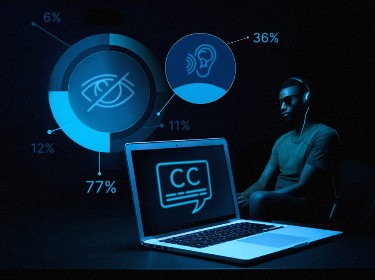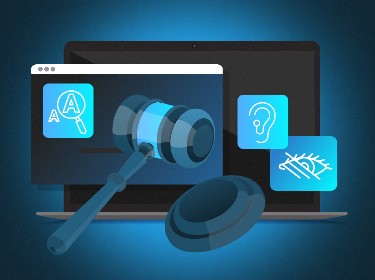Web accessibility is about enabling the digital world to be operable and within the reach of all individuals, including people with disabilities. It is important for all businesses and organizations to understand the web accessibility guidelines, the legislation, and the risks of failing to comply with these laws.
In 1990, a civil rights legislation called Americans with Disabilities Act (ADA) was passed in the US to protect the rights of people with disabilities and to prohibit any discrimination against them. According to this law, all people with disabilities have to be provided equal opportunities to participate in various programs, receive services, seek knowledge, and to express themselves freely.
In the 21st century, website accessibility laws were extended to apply beyond physical locations to include digital services and online content. That is when businesses who were previously avoiding accessible web design were starting to face website accessibility lawsuits and bare serious fines. To avoid ADA non-compliance risks, all organizations, public or private, should be aware of the legislation’s requirements regarding web accessibility, and the current web standards for accessible design.
Read on to find out more about the legal acts that govern website accessibility, the publicly accepted web content accessibility guidelines, the past ADA website lawsuit cases, and how to avoid them.
Who Needs to Follow ADA Requirements?
The Americans with Disabilities Act clearly specifies by category the organizations and institutions that are required to comply with it. Title I of ADA applies to all businesses with at least 15 full-time employees. Title II of ADA requires state and local governments to comply. Title III refers to most of the businesses and non-profit service providers in the “accommodation” and “public spaces” category.
The website falls in the realm of public spaces, and hence an equal opportunity to access it has to be provided to all individuals, regardless of any disability. Online services and digital information are also considered as public accommodation and therefore are required to be ADA compliant. A summarized list of companies and organizations that are required to comply, and are at risk of an ADA website compliance lawsuit in case of violations is provided below:
- State and local government offices
- Private companies employing 15 or more people
- Corporations that operate for the benefit of the public
- Banking Institutions
- Hotels and travel/tour agencies
- Hospitals and healthcare institutes
- Schools, universities, and educational institutions.
Website Accessibility Laws & Regulations
![]()
The laws passed to ensure companies are not discriminating against online users with disabilities include the Americans with Disabilities Act, Section 504 and Section 508 of the U.S. Rehabilitation Act, 21st Century Communications and Video Accessibility Act, and the Individuals with Disabilities Education Act. We describe each of them in more detail below.
Americans with Disabilities Act
The Americans with Disabilities Act (ADA) is one of the most comprehensive laws safeguarding and protecting the rights of the disabled. It requires that the physical design of all public spaces and buildings meet all accessibility standards, such as wheelchair access and ramps for the handicapped, facilitation for the blind, etc. It is also used as a basis for filling web accessibility complaints.
Although the ADA does not specifically mention virtual and online services, the plaintiffs have argued that online services of businesses and retail stores are closely tied to places of public accommodation, therefore they should be made accessible to people with disabilities.
U.S. Rehabilitation Act
The U.S. Rehabilitation Act is a federal law that prohibits discrimination on the basis of disability in programs conducted by federal agencies and programs receiving federal financial support. It includes two sections applicable to website accessibility:
- Section 504 of the U.S. Rehabilitation Act along with the ADA is aimed at protecting children and adults with disabilities from discrimination in schools and workplaces. It defines accessibility criteria for educational online resources.
- Section 508 of the U.S. Rehabilitation Act requires government bodies and federal services to make electronic and information technology (EIT) equally accessible to all people, including individuals with disabilities.
21st Century Communications and Video Accessibility Act
21st Century Communications and Video Accessibility Act, (CVAA) aims to address the technological and communication needs of people with disabilities in the modern digital era. The legislation is an extension of the previously enacted accessibility laws. It includes requirements for all new technologies that came into the scene in the 21st century, including mobile devices, online services, broadband, telecommunications, and digital information. The law makes it compulsory for all online content and services to be accessible and available to the disabled people.
Individuals with Disabilities Education Act
Individuals with Disabilities Education Act (IDEA) is a U.S. legislation that ensures that students with disabilities are provided with free appropriate public education. All public schools have to create an Individualized Education Program (IEP) for students with disabilities. Resources for education include online resources and materials and online tools that should be modified and tailored to meet the needs of the disabled student. The legislation aims to provide equal opportunities for learning.
ADA Non-Compliance Risks
![]()
The consequences of ignoring the needs of people with disabilities and failing to comply with state regulations not only include the large fines and penalties, expensive lawsuit settlements, but also the losses in loyal customers and failure to deliver services to a global audience. Neglecting accessible web design requirements also leads to the proliferation of discrimination and prejudice towards physically and mentally impaired individuals.
ADA Non-Compliance Penalties
There are severe fines for ADA non-compliance. These could be as high as $75,000 for the first violation. For subsequent violations, the fine could go up to $150,000. These federal fines are often reviewed annually and may be increased to match the inflation. Organizations that receive federal funding are also at risk of having their grants revoked if they are found non-compliant with ADA.
ADA Website Lawsuits and Settlements
Any person with a disability can lodge a complaint against ADA violations to the Department of Justice. The Department is authorized to investigate and file a lawsuit in the federal court if necessary. Also, a disabled person has the right to directly file a lawsuit in the federal court against an organization or government body for ADA violations.
In addition to the federal law, the local and state governments may also have their own set of laws and regulations in place supplementing the ADA. Violators may end up paying additional compensatory damages as a result.
In the past, there have been many ADA website lawsuit cases, and quite a number of these have resulted in an out of court settlement. ADA website lawsuit settlements can be as high as $6 million. In addition to the lawsuit settlements, the company would be directed by the court to make its website ADA compliant within a prescribed time frame. It would mean additional overheads with the cost of hiring consultants and developers to add accessibility features or modify an existing design according to accessibility standards.
Failing to Reach Out to Your Audience
According to the Centers for Disease Control and Prevention (CDC), one in every four American adults has a disability. By not making the online services ADA compliant, businesses and companies will miss out on reaching this wider audience of an estimated 61 million individuals, who could be potential customers. Breach of ADA means giving an edge to your competitors who comply with ADA and the accessibility criteria, along with lost opportunities of expanding your business for the global market.
Inaccessibility Leading to Global Inequality & Injustice
It is the moral obligation of every business to provide equal opportunity to all individuals to buy products or participate in services and programs, regardless of any disability. Failing to do so promotes discrimination, prejudice, and injustice towards the members of your community.
ADA Website Compliance Lawsuits & Settlements
According to Seyfarth, in 2018 there were a total of 2258 website ADA lawsuits filed to the federal court, a jump of 177% from the previous year. In 2019, the number of cases reported were almost the same.
![]()
UsableNet made a breakdown of the industries affected by website ADA lawsuits for 2019:
![]()
Let’s take a look at some of the cases of ADA website compliance lawsuits to see how failure to accommodate disabled users can cause serious damages to businesses, and especially to established brands.
Retail Web Accessibility Lawsuits & Settlements
![]()
The first major class action lawsuit was filed in 2006 by the National Federation of the Blind (NFB) against Target, a U.S. supermarket chain. NFB vs Target was an important lawsuit in the history of ADA website lawsuit cases as it established virtual spaces as places of public accommodation, where ADA would be applicable.
The judgement in this case ruled that the online services of Target were closely tied to its physical chain stores and hence were mandated to adhere to ADA. This landmark settlement prompted other businesses to take preemptive steps to ensure ADA accessibility and avoid potential litigations for any ADA violations. Target settled the case by paying NFB $6 million in damages. It also agreed to pay NFB up to $15,000 per session, for conducting training workshops on accessibility design and features, for its employees.
Another cornerstone case was filed against Winn-Dixie, also an American supermarket chain, which set a precedent for future lawsuits stipulating that failure to make a website accessible violated Title III of the Americans with Disabilities Act. The plaintiff Juan Carlos Gil, who was visually impaired tried to access their website with his screen reader but failed to do so.
An important aspect of this case was that even though ADA itself does not define any accessibility standards, for this case, the judge used Web Content Accessibility Guidelines (WCAG) 2.0 standards to evaluate Winn-Dixie’s website. This ruling reinforced the status of the WCAG as the global standard for web accessibility audit.
Hospitality Web Accessibility Lawsuits & Settlements
![]()
In 2016, Guillermo Robles, a visually-impaired man, sued Domino’s Pizza for not being able to order food because his screen reader was incompatible with Domino’s mobile app and could not read aloud its contents. Domino’s Pizza, being a place of “public accommodation”, providing goods and services to the public, was required by court to abide by the ADA and make its online services accessible to all individuals, including those with disabilities.
There was a similar case in 2017 filed by Lucia Markett against Five Guys Enterprises, a fast food restaurant. The restaurant was blamed for its website having digital barriers, which did not allow the plaintiff to navigate it and make an order online. The plaintiff’s complaint was that she was not provided an equal opportunity to access and take full advantage of the services the restaurant provided to its online customers.
In 2018, Avanti Hotel in Palm Springs faced a painful ADA website compliance lawsuit. The Claimant alleged that the hotel’s website was not accessible to people who were hard of hearing or had vision impairment. The hotel ended up paying heavy damages of $8,000-$20,000 to the plaintiff.
Media and Entertainment Web Accessibility Lawsuits & Settlements
![]()
In 2012, the National Association of the Deaf (NAD) filed a lawsuit against Netflix for not providing closed captions on online TV and movie streaming with the “Watch Instantly” option. The grounds for the case was that people with hearing impairment were not being treated equally and given equal access to “Watch Instantly”.
In 2019, a lawsuit was filed against Parkwood Entertainment, an American management and entertainment company founded by American singer Beyoncé Knowles-Carter. The plaintiff, Mary Conner, was visually impaired and claimed that she could not navigate through their website without assistance from another person.
As Mary Conner was unable to access all the services and goods offered by the provider’s website, she was eligible to file a website ADA compliance lawsuit. Conner demanded that the website be fixed to comply with accessibility standards, and also requested damages to be paid to the class action lawsuit members for being discriminated against and put at a disadvantage.
Education Industry Web Accessibility Lawsuits & Settlements
![]()
In 2012, two blind students sued Florida State University for using an e-learning system, in their mathematics course, that was not accessible to the visually impaired. The students argued that the university discriminated against them and did not provide them with equal opportunities as it does to other students. The university settled the lawsuit by paying both of these students $75,000 as compensation in damages.
Two federal class action lawsuits were filed against Harvard and MIT by National Institute of the Deaf (NAD) for not providing captions in their online content and courses including massive open online courses (MOOCs). The universities have made their educational content freely available to the general public around the world, but the plaintiff claimed that the deaf were discriminated against by not being given an equal opportunity to fully understand the content or access their knowledge base.
After four years of legal action, a settlement was reached in which Harvard was directed to include industry standard captions to all its publicly available video and audio streams. Harvard was also made liable to pay $1.5 million for class counsel’s costs and attorney fees.
Recently in June 2020, an ADA lawsuit for website non-compliance was filed against Duke University by Mary Fernandez, a visually impaired student, for not providing adequate tools for accessing the university’s website for admission, setting up a user profile, accessing complete course information, etc. She was entitled to filing the ADA compliance website lawsuit on the grounds that she was not provided the same level of access to university online resources and services as other students.
Following the WCAG Standard to Avoid Lawsuits
![]()
The Web Content Accessibility Guidelines (WCAG) document is the globally accepted standard defined by the World Wide Web Consortium (W3C) for accessible web design. It establishes three levels of accessibility for online and digital services:
- Level A as the minimum level of accessibility required for individuals to be able to access digital content.
- Level AA as the medium level of accessibility required for individuals to be able to access digital content and easily navigate it, without having any barriers.
- Level AAA as the maximum level of accessibility required for individuals to be able to access digital content, having an additional interface layer, providing the most convenient experience.
Level AAA may not be achievable for various types of web content, while Level AA compliance is the minimum required level for making your website accessible and avoiding lawsuits filed to court. Past records of ADA lawsuit website documents show that the judges often referred to specific WCAG 2.0 standards for accessibility. Check out our full guide to website accessibility to understand how to use the WCAG guidelines to accommodate users with various disabilities, including visual, hearing, motor, and cognitive impairments.
Targets for meeting accessibility standards should be clearly defined and incorporated into the design of web and online content before starting development. While preparing your digital content, the text, audio, video, graphics, and illustrations should be provided with their alternatives and have formats that are supported by the users’ assistive technologies. The content managers and developers should be given training and workshops to educate them on the ADA and adjacent regulations, on WCAG guidelines, methods and techniques of implementation, and the consequences of ADA non-compliance.
It is highly advisable to hire expert ADA consultants to ascertain the level of your website’s accessibility, provide guidance on remediation, and maintaining accessible design. Regular audits should be undertaken to ensure that the ADA accessibility features are in place.
ADA Website Compliance Costs
![]()
The costs of incorporating ADA compliance in existing websites or when creating a new website are far less as compared to the damages paid due to non-compliance. For instance, in the case provided earlier, Win-Dixie could have saved itself from the litigation costs and bad publicity from ADA non-compliance by simply adding the website accessibility features to its website at a small additional cost.
Costs of ADA compliant website design or remediation depend on a number of factors:
- Number of unique web pages & layouts
- Types of multimedia content integrated
- Amount of online forms and interactive features
- Third-party tools and technologies used.
The average cost of a full ADA compliance audit ranges from 1,000 to 1,500 USD. Remediation or the development of a fully-accessible website can cost anywhere from 3,000 to 20,000 USD, depending on a particular case and severity of the issues. Regular auditing and maintenance adds up a monthly cost between 500 and 1,000 USD.
Organizations and businesses can also resort to automated tools for website scans to detect ADA violations. However, these tools detect up to 30% of compliance issues. Manual audits and testing is another option to identify ADA non-observance. It is also important to test assistive tools, e.g., screen readers and other technologies to ensure that the website is ADA compliant.
Overall, the costs of remediation for websites and applications vary depending upon the WCAG criteria that have been violated, the number of violations, and the type of content presented within your digital product.
How Do You Avoid Web Accessibility Lawsuits?
We’re witnessing a continuing growth of lawsuits related to ADA non-compliance from year to year. Every business and organization is at risk, regardless of its size or domain. So awareness and proactive approach is the key to avoiding painful accessibility litigation, penalties, and fines.
Running your website through an accessibility audit based on the WCAG guidelines can help you find weak spots in your design. Testing needs to be carried out by putting yourself in place of the disabled user, using assistive technologies, and making sure all of your content is readable and perceivable. Maintaining WCAG compliance helps businesses engage with a much wider audience, increasing exposure to their products and services, and boosting sales.
If you are not sure about your website’s full accessibility and compliance with state regulations, a good idea is to ask for assistance from an expert web accessibility consulting company like PixelPlex. We offer you both consultancy services, and accessible web design & development as well.




